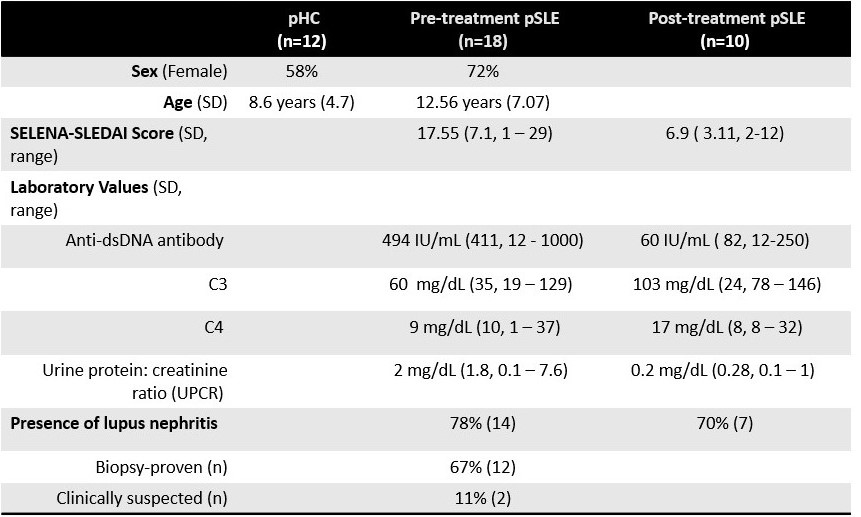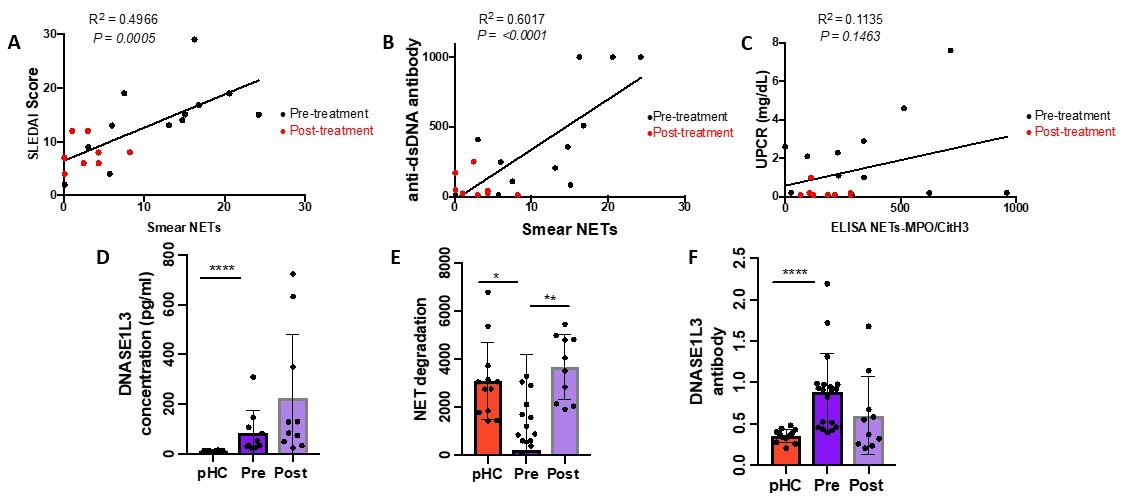Session Information
Session Type: Poster Session C
Session Time: 10:30AM-12:30PM
Background/Purpose: Pediatric lupus (pSLE) is a multisystemic, chronic, autoimmune disease in which over 50% of pSLE patients develop lupus nephritis (pLN). Neutrophil extracellular traps (NETs) are considered a potential source of antigen, leading to autoantibody production. NETs can activate plasmacytoid dendritic cells to produce high levels of interferon-α, a known driver of the pathogenesis of lupus. Preliminary data from our lab demonstrated higher levels of circulating NETs in pSLE patients compared to healthy children. These patients have impaired NET degradation and decreased DNASE1L3 activity, which could be due to blocking anti-DNASE1L3 antibodies. Higher double-stranded DNA antibody levels and SELENA-SLEDAI scores correlated with elevated levels of NETs. To date, the role of NETs in the pathogenesis of pSLE remains unknown. We hypothesize that elevated levels of NETs seen in treatment-naïve pSLE patients are abrogated by the induction therapy, and aim to characterize NET degradation post-treatment.
Methods: Plasma was obtained from 18 pSLE treatment-naïve patients and 12 age- and sex-matched healthy children. Multiplex ELISA was used to detect small quantities of NET remnants using a combination of MPO-CitH3 antibody cocktail, followed by DNA detection. Immunofluorescence smear assay was used to visualize and quantify NETs. Anti-NET, anti-DNASE1L3, and DNASE1L3 concentration were determined by ELISA. NET degradation assay was used as an indirect measure of DNASE activity. Disease activity was measured using SELENA-SLEDAI, double-stranded DNA antibodies, Urine protein/creatinine ratio (UPCR). Correlation analyses were performed on these variables. Plasma was obtained from 10 of 18 patients’ post-treatment and the same assays used to assess circulating NET levels.
Results: 72% pSLE patients were female. 38% of patients were Asian, 28% were African American and 28% Hispanic. No known hypomorphic DNASE1L3 RC206 mutations were detected. Mean SELENA-SLEDAI scores were 17.5 ± 7.1 pre-treatment and 6.9 ± 3.1 post-treatment (Table 1). All patients received corticosteroids and an immunosuppressive medication as induction therapy, primarily mycophenolate, cyclophosphamide, or rituximab, depending on disease severity. SELENA-SLEDAI score, double stranded DNA antibody levels, and urine protein/creatine ratios were all decreased post-treatment, indicating lower disease activity (Figure 1A-C). Pre-treatment pSLE patients with higher circulating NET levels had lower levels post-treatment (Figure 1D and 1F). Previously impaired NET degradation was restored post-treatment. (Figure 2E). DNASE1L3 antibody levels, which inhibit DNASE1L3 activity, were decreased post-treatment. (Figure 2F).
Conclusion: pSLE patients have increased levels of circulating NETs, and these levels become decreased post-induction with broad immunosuppression, associated with decreased disease activity and restored NET degradation. Understanding mechanisms of NETosis in pSLE may allow for the development of new therapies targeting NET degradation. Studies investigating the presence of NETs at the end organ using renal biopsy specimens are currently underway.
To cite this abstract in AMA style:
Borja T, Matta B, Thomas L, Battaglia J, Huang A, Simpfendorfer K, Wen H, Hui-Yuen J, Reizis B, Makita S, Barnes B. Reduction in Circulating Neutrophil Extracellular Traps and Restored Degradation Post-treatment in Pediatric Lupus [abstract]. Arthritis Rheumatol. 2024; 76 (suppl 9). https://acrabstracts.org/abstract/reduction-in-circulating-neutrophil-extracellular-traps-and-restored-degradation-post-treatment-in-pediatric-lupus/. Accessed .« Back to ACR Convergence 2024
ACR Meeting Abstracts - https://acrabstracts.org/abstract/reduction-in-circulating-neutrophil-extracellular-traps-and-restored-degradation-post-treatment-in-pediatric-lupus/



